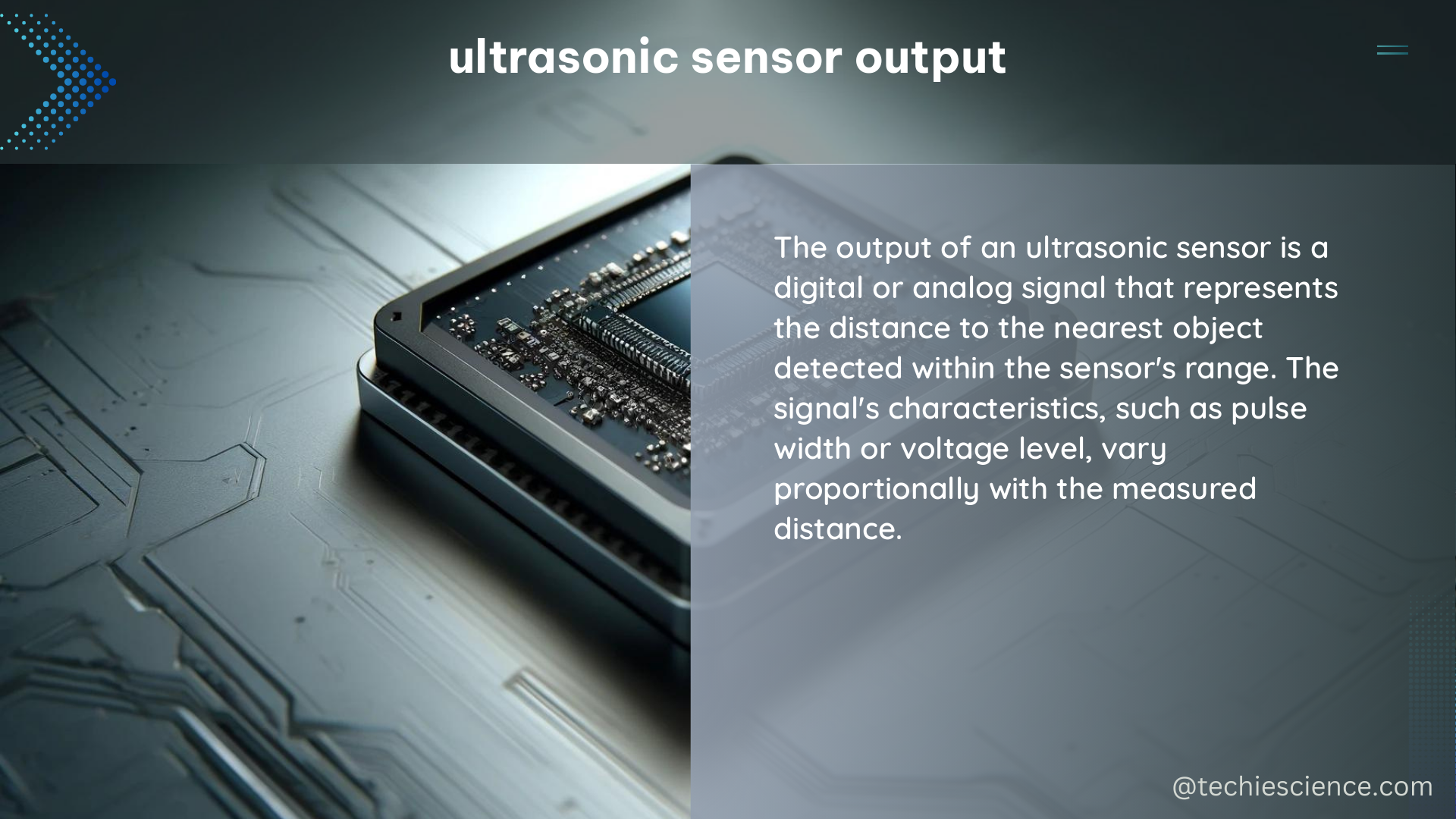The ultrasonic sensor output is a precise time measurement that is converted into a distance measurement using the speed of sound. This sensor is widely used in various applications, such as robotics, automation, and security systems, due to its ability to accurately detect the presence and distance of objects. In this comprehensive guide, we will delve into the intricacies of the ultrasonic sensor output, providing you with a deep understanding of its technical specifications, factors that influence its performance, and practical applications.
Understanding the Fundamentals of Ultrasonic Sensor Output
Ultrasonic sensors work by emitting high-frequency sound waves and measuring the time it takes for those waves to bounce back after hitting an object. This time measurement, known as the “time of flight” (ToF), is then converted into a distance measurement using the speed of sound.
The formula for calculating the distance is:
Distance = (Duration × Speed of Sound) / 2
Where:
– Distance is the measured distance in centimeters (cm)
– Duration is the time of flight in microseconds (μs)
– Speed of Sound is approximately 343 meters per second (m/s) or 34,300 centimeters per second (cm/s)
The division by 2 is necessary because the sound wave travels to the object and back, so the total distance traveled is twice the distance to the object.
Exploring the Technical Specifications of Ultrasonic Sensors

Ultrasonic sensors come in various models, each with its own set of technical specifications. Let’s take a closer look at the specifications of the popular HC-SR04 ultrasonic sensor:
| Specification | Value |
|---|---|
| Operating Voltage | 5V DC |
| Quiescent Current | 2 mA |
| Working Current | 15 mA |
| Ranging Distance | 2 cm to 400 cm |
| Ranging Accuracy | 3 mm |
| Beam Angle | 15 degrees |
| Trigger Input Signal | 10 μs TTL pulse |
| Echo Output Signal | TTL level signal |
| Dimension | 45 mm × 20 mm × 15 mm |
| Weight | 9 g |
These specifications provide valuable information about the sensor’s capabilities, power requirements, and physical dimensions, which are crucial when integrating the sensor into your project.
Factors Affecting Ultrasonic Sensor Output
The output of an ultrasonic sensor can be influenced by various environmental and physical factors. Understanding these factors is essential for ensuring accurate distance measurements and reliable sensor performance.
-
Temperature: The speed of sound is affected by temperature. As the temperature increases, the speed of sound also increases, and vice versa. This can lead to inaccuracies in the distance calculation if the temperature is not accounted for.
-
Humidity: Humidity can also affect the speed of sound, although to a lesser extent than temperature. Higher humidity levels can slightly increase the speed of sound, leading to small distance measurement errors.
-
Angle of Incidence: The angle at which the sound wave hits the target object can impact the sensor’s ability to detect the reflected signal. Perpendicular angles (90 degrees) generally provide the best results, while oblique angles can cause the sound wave to be reflected away from the sensor.
-
Surface Characteristics: The material and surface texture of the target object can influence the sensor’s ability to detect the reflected sound wave. Smooth, flat surfaces tend to provide better reflections, while irregular or absorptive surfaces may result in weaker or scattered reflections.
-
Interference: Nearby ultrasonic sources, such as other ultrasonic sensors or high-frequency sound-producing devices, can interfere with the sensor’s operation and lead to inaccurate distance measurements.
To mitigate the effects of these factors, it is recommended to calibrate the ultrasonic sensor and implement compensation algorithms in your software or firmware.
Practical Applications of Ultrasonic Sensor Output
Ultrasonic sensors are widely used in a variety of applications due to their ability to accurately measure distances without physical contact. Here are some common applications:
-
Robotics and Automation: Ultrasonic sensors are used in robots and automated systems for object detection, collision avoidance, and proximity sensing.
-
Security and Surveillance: Ultrasonic sensors can be used in security systems to detect the presence of intruders or monitor the movement of objects within a defined area.
-
Level Measurement: Ultrasonic sensors can be used to measure the level of liquids or granular materials in tanks, silos, or other containers.
-
Parking Assistance: Ultrasonic sensors are commonly used in vehicles to assist with parking by detecting the distance to nearby objects, such as walls or other cars.
-
3D Mapping and Scanning: Ultrasonic sensors can be used in combination with other sensors to create 3D maps of environments, which can be useful in applications like autonomous navigation and virtual reality.
Conclusion
The ultrasonic sensor output is a powerful tool for accurately measuring distances and detecting the presence of objects. By understanding the technical specifications, factors that influence the sensor’s performance, and practical applications, you can effectively integrate ultrasonic sensors into your projects and achieve reliable and accurate results.
Remember to always consider the environmental and physical factors that can affect the sensor’s output, and implement appropriate calibration and compensation techniques to ensure the best possible performance.
References:
- Arduino Forum. (2013). Suggest an ultrasonic sensor. Retrieved from https://forum.arduino.cc/t/suggest-an-ultrasonic-sensor/158896
- Stack Overflow. (2022). How to setup ultrasonic sensor to return values after 1 second. Retrieved from https://stackoverflow.com/questions/72502409/how-to-setup-ultrasonic-sensor-to-return-values-after-1-second
- Reddit. (2022). Size of data from Arduino ultrasonic sensor. Retrieved from https://www.reddit.com/r/arduino/comments/z0dkw7/size_of_data_from_arduino_ultrasonic_sensor/
- How to Mechatronics. (n.d.). Ultrasonic Sensor HC-SR04 and Arduino – Complete Guide. Retrieved from https://howtomechatronics.com/tutorials/arduino/ultrasonic-sensor-hc-sr04/

The lambdageeks.com Core SME Team is a group of experienced subject matter experts from diverse scientific and technical fields including Physics, Chemistry, Technology,Electronics & Electrical Engineering, Automotive, Mechanical Engineering. Our team collaborates to create high-quality, well-researched articles on a wide range of science and technology topics for the lambdageeks.com website.
All Our Senior SME are having more than 7 Years of experience in the respective fields . They are either Working Industry Professionals or assocaited With different Universities. Refer Our Authors Page to get to know About our Core SMEs.